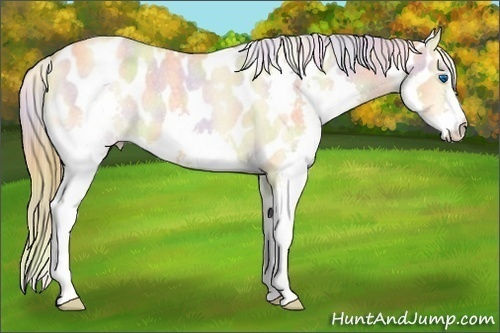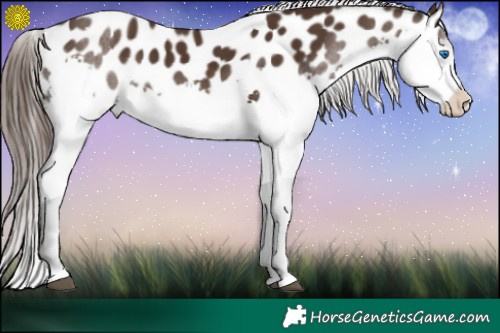X
HGG Community Forums
Log In to HorseGeneticsGame
HGG Community Forums
Join our discord server!
Howdy, Stranger!
It looks like you're new here. If you want to get involved, click one of these buttons!
Categories
- All Discussions68,267
- Announcements381
- HJ2 Discussion67,060
- ↳ New Member Introductions569
- ↳ Help me out3,469
- ↳ Horses For Sale and Auction12,515
- ↳ Breeding Ads and Sales3,456
- ↳ Herd Helper39,570
- ↳ Bug Discussion120
- ↳ Repair Log12
- General Discussion826
- ↳ Saddle Sisterhood32
- ↳ Games, Contests and GiveAWays54
- ↳ Genetics245
In this Discussion
- Ammit April 2018
- Cheers April 2018
- ConfluenceFarms April 2018
- CrewCut April 2018
- fj1482 April 2018
- HTRanch May 2018
- JustaSaddletramp April 2018
- kintara May 2018
- pestilenttempest May 2018
- Ren May 2018
- Salvistar April 2018
- Wildland Acres April 2018
- XXVI Stud April 2018
Who's Online (0)
Spot size in Appaloosas
-
Are there any factors that increase spot size in Appaloosas?ID# 43830
|<> Favorite flavors: wild bay, S+, satin, and ice 9. <>| -
Sooty tends to make for larger spots.
-
Here it is.
http://hj2.huntandjump.com/forum/discussion/comment/77381#Comment_77381
From what I’ve gathered genetics does influence spot size, but it’s unknown what genes effect it and hidden genes may be involved. I am not up to date on what was discussed in the thread though.SALVISTAR PERFORMANCE HORSES
Barn ID - 2358 -
It was determined that spot size is a invisible gene. There was something like 8 different spot sizes that we found. I think we came to the conclusion that it worked similar to white factor. The parents had a range of numbers they could pass on and the number the foal had effected spot size. It was a really cool thread and project that many of us helped on.
-
Huge if true. (it's not :P)
___________
Need to contact me? Read this first.
http://www.huntandjump.com/forum/discussion/3/how-to-get-help-from-an-administrator -
Ammit, the complexity of this game continues to amaze me!
The thread was helpful as well. In regards to the spots, maybe I’ll do research on real life spot size on Appies and see if it matches anything in game....ID# 43830
|<> Favorite flavors: wild bay, S+, satin, and ice 9. <>| -
:)) @Ammit
I love LP horses and have since I met Ulrich's Monarch when I was a kid, and I've followed the genetics discussions about them for years. Spot size is thought to be inherited, but it's definitely not something you can count on with most bloodlines. I've seen mares with tiny confetti spots bred to a solid stud and throw foals with spots the size of eggs, or loud leopards throw foals with tiny freckles. lol
There do seem to be lines that breed truer for the big spots more often than not, but not many. Many appy breeders, no matter what breed the LP pattern is found in, swear by breeding spots to solids for the best patterns. I know a few with LPLP mares who use solid foundation-bred stallions with really nice results, but sometimes you can breed even a fewspot and get a foal with just one or two spots.
One line that is known for strongly defined patterns is the Wap's Spot 2 bloodline, but some think he had another gene that interacts with PATN. A lot of Wap-bred horses show patterns that are recognizable if you know the bloodline, especially the linebred ones, but even they don't always throw the loud patterns they're known for.Justa ~ ID# 44842
A chronic sufferer of shiny pony syndrome breeding for DP, Pearl, Brown, Nexus, and Watercolor in Appaloosa, Dun, Sabino 2, and Kit M patterns.
"God grant me the hbs to buy the ponies I need,
The fortitude to resist the shiny ones I truly don't,
And the wisdom to know there will always be more next time." -
Yeah, I think in real life a lot of it has to do with other genes suppressing or enhancing spot size, but from the searches I did, I don't think that's true in-game. My guess is it is a very long chain of secret numbers and if-then statements in the game code.ID# 43830
|<> Favorite flavors: wild bay, S+, satin, and ice 9. <>| -
In game the only thing I’m sure of (semi-confirmed by Ammit) is that larger spots are associated with more darkening genes and smaller spots with less. So if you want to breed for megadots, starting with Hom DP Hom Sooty stock is helpful, and if you want microdots then you want all bright (no sooty) stock.
-
Thanks, Cheers! I am in the process right now of using the search to amass groups of horses with the Lp complex as well as some different genes and sorting them by spot size on Pinterest. Once I get sample sizes above 20, I'll test the groups for any statistical significance. Right now I'm interested in sb1 and splash because those two genes seem to affect Appaloosa patterning irl. I might find something, cool, I might not, but the process is fun!ID# 43830
|<> Favorite flavors: wild bay, S+, satin, and ice 9. <>|Thanked by 1JustaSaddletramp -
GUYS. BREAKTHROUGH.
I just used a random number generator to randomly sample 108 horses het for Lp (so I could see spot size) and carrying Splash 1 (both het and hom). 85 horses were classified as having small spots; 23 had mega spots. I then used a theory-based test to analyze the results, and ended up with a p-value of 0.0000. Statistically, this means that there is extremely strong evidence that the splash gene is associated with small spots in heterozygous appies. Correlation does not equal causation, but these results could be generalized to all heterozgous Lp horses carrying Splash 1.
@Ammit, how did I do?ID# 43830
|<> Favorite flavors: wild bay, S+, satin, and ice 9. <>| -
Totally wrong lol.
As to the above. Not sure why you would assume I would not go with the real life version of how things work.
___________
Need to contact me? Read this first.
http://www.huntandjump.com/forum/discussion/3/how-to-get-help-from-an-administrator -
And yes I have confirmed pigment density effects spot size.
___________
Need to contact me? Read this first.
http://www.huntandjump.com/forum/discussion/3/how-to-get-help-from-an-administrator -
Ah, well. I’ll just have to do different research I guess.ID# 43830
|<> Favorite flavors: wild bay, S+, satin, and ice 9. <>| -
Ok, so another hypothesis, which is probably totally wrong =))
If, as Ammit said, pigment density affects spot size (at least in reference to sooty,) then would agouti also operate in this manner (at least on E horses?) Homozygous recessive agouti (aa) enables black pigment, but a dominant agouti gene restricts black pigment to certain areas, causing the lighter-colored body of a classic bay horse. But there are three agouti genes in the game and all three enable different levels of black pigment. And I don't really know how this would apply to chestnuts.ID# 43830
|<> Favorite flavors: wild bay, S+, satin, and ice 9. <>| -
In order of pigment density Chestnut < Wild Bay < Bay < Brown < Black. Other genes can increase or reduce pigment density from there.
___________
Need to contact me? Read this first.
http://www.huntandjump.com/forum/discussion/3/how-to-get-help-from-an-administrator -
A black chestnut obviously has more pigment then a classic bay.
___________
Need to contact me? Read this first.
http://www.huntandjump.com/forum/discussion/3/how-to-get-help-from-an-administrator -
Ok. So would dilutions have an affect as well? (cream, dun, silver, etc?)
And yes, I am noticing that if a horse is hom sty, it tends to have larger spots regardless of other factors (although this is not always true!)ID# 43830
|<> Favorite flavors: wild bay, S+, satin, and ice 9. <>| -
All dilutions alter the amount of pigment. :D You are on the right track now.
___________
Need to contact me? Read this first.
http://www.huntandjump.com/forum/discussion/3/how-to-get-help-from-an-administratorThanked by 1JustaSaddletramp -
Yay! So, to sum up, Appaloosa patterns work differently than other white patterns. While other white patterns like tobiano or sabino are affected by white factor among other things, Appaloosa patterns are affected by pigment density.
This makes me so excited!
ID# 43830
|<> Favorite flavors: wild bay, S+, satin, and ice 9. <>|Thanked by 1JustaSaddletramp -
Is the modeling in the game based on the Druml paper published last year?ID 125
-
I came across that paper and it sounded interesting, but I had to pay in order to read it.ID# 43830
|<> Favorite flavors: wild bay, S+, satin, and ice 9. <>| -
I got a freaky friday happy once, the size of her spots were amazing! If only I bred for appy...
-
Our appy system went in before that paper went out but it was nice to see it confirmed.
___________
Need to contact me? Read this first.
http://www.huntandjump.com/forum/discussion/3/how-to-get-help-from-an-administratorThanked by 1Lallyhop -
That makes sense, this game is so cool in its mechanics! I love how realistic it is.
@HTRanch I'm a graduate student in the biology department at my university so I had free access to it. Otherwise I wouldn't be able to read it because it's not cheap! I read it when it came out last year and thought it was pretty neat :)ID 125Thanked by 1Ammit -
@XXVI Stud it sounds really neat! I checked through my school but I don't have a science-y major so I couldn't get to it. In high school I wanted to be a vet and was a bit of a genetics nerd so it would be fun to track down. Now who do I know in the bio department... lolID# 43830
|<> Favorite flavors: wild bay, S+, satin, and ice 9. <>| -
I’ve been following this thread because it’s super interesting. lo And behold I got this goal to drop this morning. I’m in love with the large spots. I think I’m going to have to gmt my freaky Friday stud

Macc 2032839
Thanked by 1Lallyhop -
I've been silently stalking this thread as well mainly because my main goal right now is breeding for large spotted appys. Looks like there might be a few more large spotted breeders around, yay! I'll admit that mainly I've been focusing on getting my line to have hom sty as best I can. This month the largest spotted girls I have are being paired with my largest spotted stud and we'll see what happens. I can't wait until next month when my FF, GMT, Macchiato boy will be 3 then I can mix in some DP and really have fun with things.

RS Freaky FunhouseID: 40723 -
I love the big spots, my herds have a lot of sty and DP, but also a lot of dilutions! Certainly my DP horses mostly seem to have bigger spots, but I also have livers with tiny spots, and browns with tiny spots. So I'm thinking pigment density isn't the only thing that affect spot size? So there is no genetic proponent?
I LOVE that colt pestilenttempest, those coloured spots are awesome!! -
I bred this one, and he definitely has mega spots! Of course he was snipped, though. And @kintara, I was noticing the same thing with some DP horses with small spots. I was thinking about doing some test breedings to small-spot DP carriers to see what happens.

HT ff x ffID# 43830
|<> Favorite flavors: wild bay, S+, satin, and ice 9. <>|Thanked by 1kintara









